For the short term, a pullback was expected for this session. Price moved reasonably below the target at 3,107 to find a low at 3,091.41, 15.59 points below the target.
Price remains above the invalidation point and has bounced up strongly off the low.
Summary: The upwards trend should resume. The next target at 3,179 is where minor wave 4 may begin (expect it to be very shallow). Thereafter, the next target is at 3,302 and then 3,336.
Three large pullbacks or consolidations during the next few months are expected: for minor wave 4, then intermediate (4), and then primary 4. Prior to each of these large corrections beginning, some weakness may begin to be evident.
The biggest picture, Grand Super Cycle analysis, is here.
Monthly charts were last published here, with video here. There are two further alternate monthly charts here, with video here.
ELLIOTT WAVE COUNTS
The two weekly Elliott wave counts below will be labelled First and Second. They may be about of even probability. When the fifth wave currently unfolding on weekly charts may be complete, then these two wave counts will diverge on the severity of the expected following bear market. To see an illustration of this future divergence monthly charts should be viewed.
FIRST WAVE COUNT
WEEKLY CHART
The basic Elliott wave structure consists of a five wave structure up followed by a three wave structure down (for a bull market). This wave count sees the bull market beginning in March 2009 as an incomplete five wave impulse and now within the last fifth wave, which is labelled cycle wave V. This impulse is best viewed on monthly charts. The weekly chart focusses on the end of it.
Elliott wave is fractal. This fifth wave labelled cycle wave V may end a larger fifth wave labelled Super Cycle wave (V), which may end a larger first wave labelled Grand Super Cycle wave I.
The teal Elliott channel is drawn using Elliott’s first technique about the impulse of Super Cycle wave (V). Draw the first trend line from the end of cycle wave I (off to the left of the chart, the weekly candlestick beginning 30th November 2014) to the end of cycle wave III, then place a parallel copy on the end of cycle wave II. This channel perfectly shows where cycle wave IV ended at support. The strongest portion of cycle wave III, the end of primary wave 3, overshoots the upper edge of the channel. This is a typical look for a third wave and suggests the channel is drawn correctly and the way the impulse is counted is correct.
Within Super Cycle wave (V), cycle wave III is shorter than cycle wave I. A core Elliott wave rule states that a third wave may never be the shortest. For this rule to be met in this instance, cycle wave V may not be longer in length than cycle wave III. This limit is at 3,477.39.
Cycle wave V may subdivide either as an impulse or an ending diagonal. Impulses are much more common. An alternate wave count, which looked at the possibility of a diagonal unfolding, has been invalidated with a new all time high.
The daily chart below will focus on movement from the end of intermediate wave (1) within primary wave 3.
In historic analysis, two further monthly charts have been published that do not have a limit to upwards movement and are more bullish than this wave count. Members are encouraged to consider those possibilities (links below summary) alongside the wave counts presented on a daily and weekly basis.
Within cycle wave V, primary waves 1 and 2 may be complete. Within primary wave 3, intermediate waves (1) and (2) may be complete. Within the middle of intermediate wave (3), no second wave correction may move beyond its start below 2,855.96.
DAILY CHART
All of primary wave 3, intermediate wave (3) and minor wave 3 may only subdivide as impulses.
Minor wave 3 may be underway and may be nearing its end. Minor wave 3 now shows an increase in momentum beyond minor wave 1; MACD supports this wave count.
Minor wave 4 may not move into minor wave 1 price territory below 3,021.99.
Intermediate wave (3) must move far enough above the end of intermediate wave (1) to then allow intermediate wave (4) to unfold and remain above intermediate wave (1) price territory. While intermediate wave (3) has now moved beyond the end of intermediate wave (1), meeting a core Elliott wave rule, it still needs to continue higher to give room for intermediate wave (4).
The target for intermediate wave (3) fits with a target calculated for minor wave 3.
Minor wave 2 was a sharp deep pullback, so when it arrives minor wave 4 may be expected to be a very shallow sideways consolidation to exhibit alternation. Minor wave 2 lasted 2 weeks, so minor wave 4 may be about the same duration to have good proportion.
Draw an Elliott channel about minor wave 3 using Elliott’s first technique: draw the first trend line from the end of minute wave i to minute wave iii, then place a parallel copy on the end of minute wave ii. Copy this channel over to the hourly chart. The channel may show where minute wave v finds support and resistance along the way up. Yesterday price reacted down from the upper edge of the channel.
HOURLY CHART
Within minor wave 3, minute wave iv subdivides as a small triangle, and minute wave v has begun and may only subdivide as a five wave motive structure, either an impulse or an ending diagonal. Impulses are more common in fifth wave positions and that is what shall be expected unless overlapping suggests a diagonal.
Within minute wave v, minuette waves (i) and (ii) may be complete. Minuette wave (ii) may have completed as an expanded flat correction. Within the expanded flat, subminuette wave b is a 1.85 length of subminuette wave a, and subminuette wave c is just 0.64 points longer than 4.236 the length of subminuette wave a.
It remains possible that minuette wave (ii) may continue lower. If it does, then it may not move beyond the start of minuette wave (i) below 3,085.31.
SECOND WAVE COUNT
WEEKLY CHART
This weekly chart is almost identical to the first weekly chart, with the sole exception being the degree of labelling.
This weekly chart moves the degree of labelling for the impulse beginning in March 2009 all down one degree. This difference is best viewed on monthly charts.
The impulse is still viewed as nearing an end; a fifth wave is still seen as needing to complete higher. This wave count labels it primary wave 5.
Primary wave 5 may be subdividing as either an impulse, in the same way that cycle wave V is seen for the first weekly chart.
TECHNICAL ANALYSIS
WEEKLY CHART
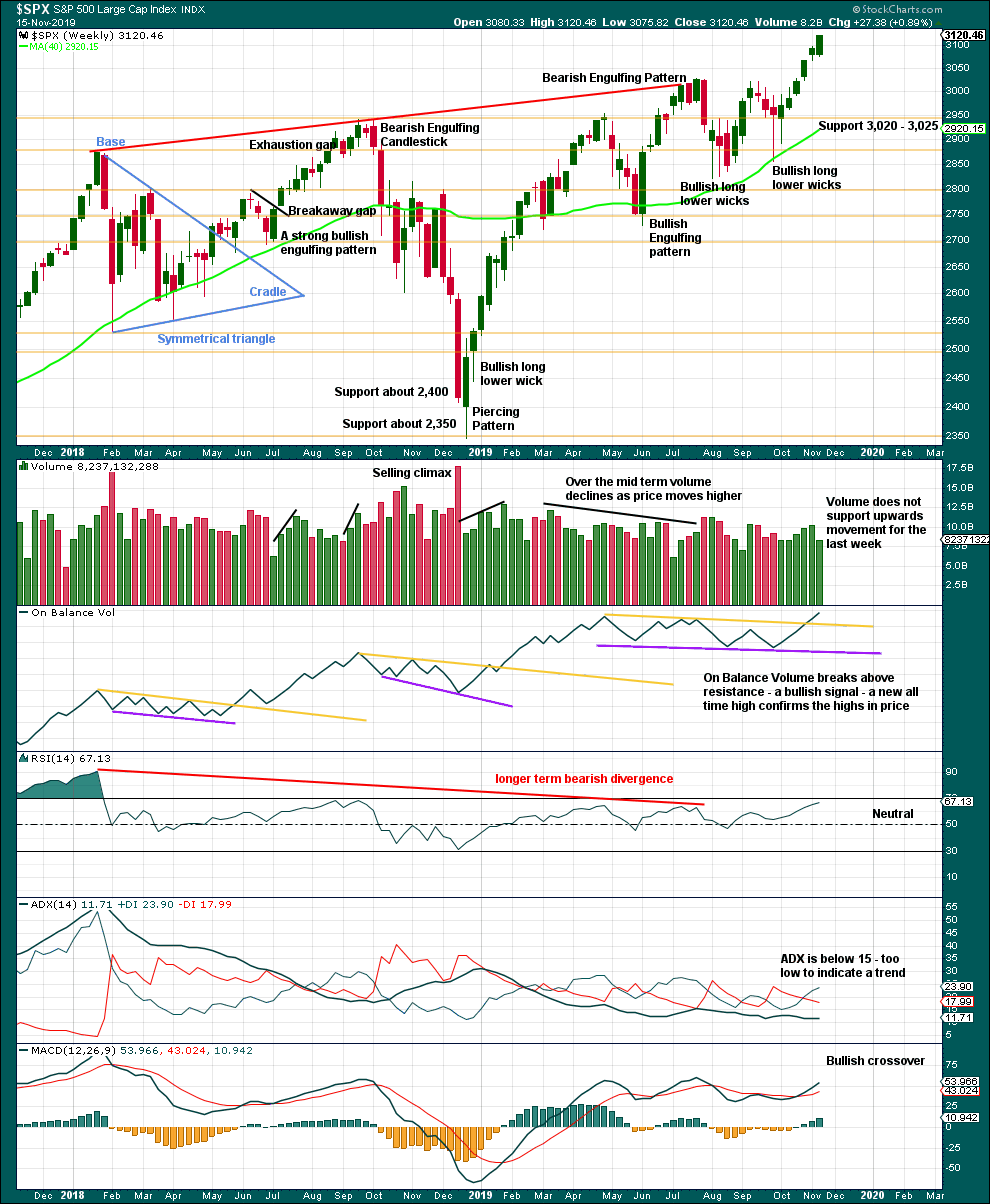
Click chart to enlarge. Chart courtesy of StockCharts.com.
It is very clear that the S&P is in an upwards trend and the bull market is continuing. Price does not move in straight lines; there will be pullbacks and consolidations along the way.
Now that resistance has been overcome, energy has been released to the upside and there are now six green weekly candlesticks in a row. Corrections are normal and to be expected; they may be more short term in nature at this stage.
Last week price has closed near highs for the week; more upwards movement may be expected this week.
Some decline overall in volume last week is not of a great concern in current market conditions. This may be an early development of some weakness as minor wave 3 nears its end.
DAILY CHART
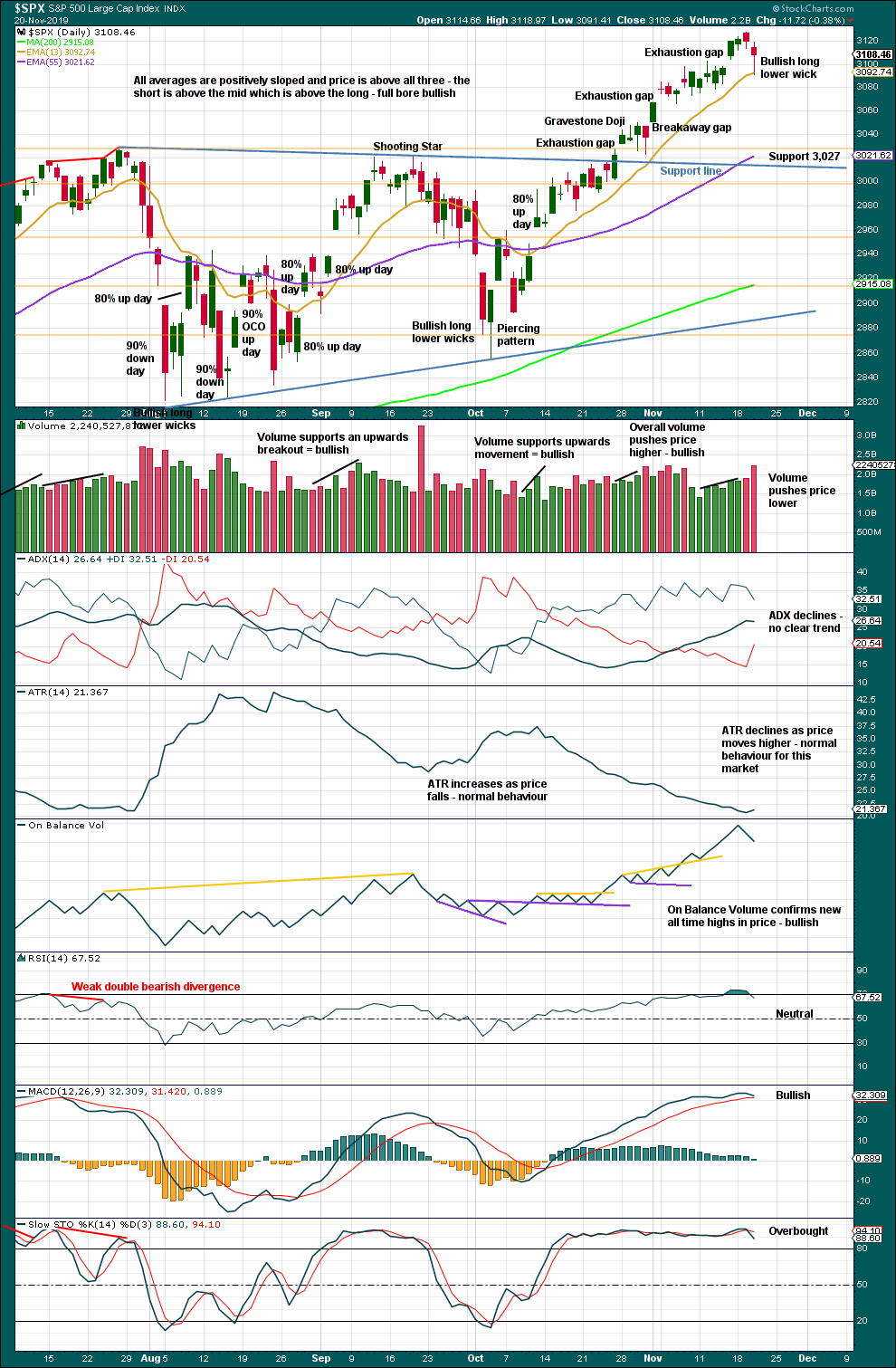
Click chart to enlarge. Chart courtesy of StockCharts.com.
There is an upwards trend in place. There will be corrections along the way.
The breakaway gap is today closed with a new low below 3,098.20. Although this is now correctly renamed an exhaustion gap, this has happened recently yet price continued to move higher.
The bullish long lower wick today suggests the pullback may be complete and upwards movement may resume tomorrow.
When this market is in a bullish trend, RSI can reach deeply overbought and remain there for some weeks. This small pullback has brought RSI down from overbought back into neutral territory, but only just. There is again a little room for price to move higher.
BREADTH – AD LINE
WEEKLY CHART
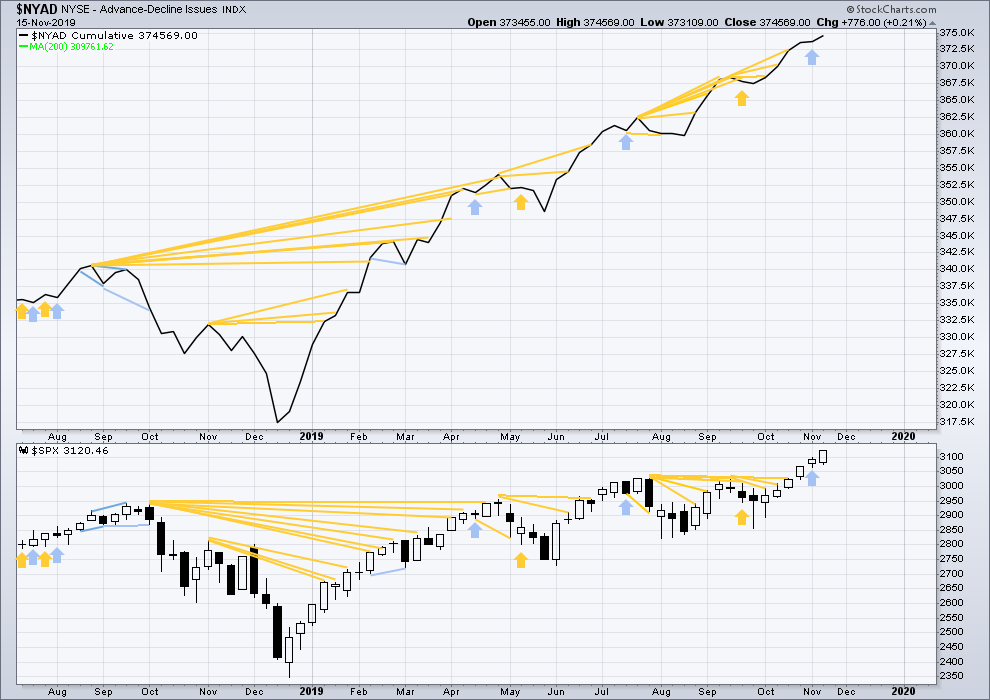
Click chart to enlarge. Chart courtesy of StockCharts.com. So that colour blind members are included, bearish signals
will be noted with blue and bullish signals with yellow.
Bear markets from the Great Depression and onwards have been preceded by an average minimum of 4 months divergence between price and the AD line with only two exceptions in 1946 and 1976. With the AD line making new all time highs last week, the end of this bull market and the start of a new bear market is very likely a minimum of 4 months away, which is mid March 2020.
In all bear markets in the last 90 years there is some positive correlation (0.6022) between the length of bearish divergence and the depth of the following bear market. No to little divergence is correlated with more shallow bear markets. Longer divergence is correlated with deeper bear markets.
If a bear market does develop here, it comes after no bearish divergence. It would therefore more likely be shallow.
All of small, mid and large caps have made new swing highs above the prior swing high on the 13th of September, but only large caps have made new all time highs. This upwards movement appears to be mostly driven by large caps, which is a feature of aged bull markets. This bull market at over 10 years duration certainly fits the definition of aged.
Mid and small caps have not yet made new all time highs.
Last week both price and the AD line have made new all time highs. Upwards movement has support from rising market breadth. This is bullish.
DAILY CHART
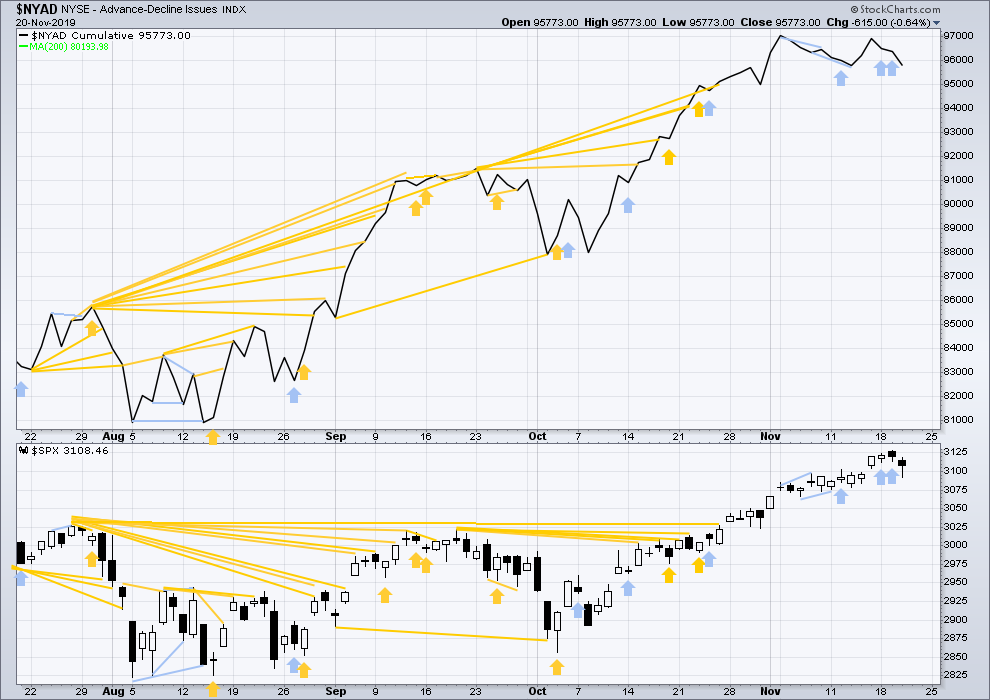
Click chart to enlarge. Chart courtesy of StockCharts.com. So that colour blind members are included, bearish signals
will be noted with blue and bullish signals with yellow.
Breadth should be read as a leading indicator.
Today both price and the AD line have moved lower. Neither have made new short-term swing lows. There is no new divergence.
This downwards movement may have resolved bearish signals, or price may yet move a little lower before they are resolved.
VOLATILITY – INVERTED VIX CHART
WEEKLY CHART

Click chart to enlarge. Chart courtesy of StockCharts.com. So that colour blind members are included, bearish signals
will be noted with blue and bullish signals with yellow.
The all time high for inverted VIX was on 30th October 2017. There is now over two years of bearish divergence between price and inverted VIX.
The rise in price is not coming with a normal corresponding decline in VIX; VIX remains elevated. This long-term divergence is bearish and may yet develop further as the bull market matures.
This divergence may be an early warning, a part of the process of a top developing that may take years. It may is clearly not useful in timing a trend change from bull to a fully fledged bear market.
Last week price moves higher, but inverted VIX is essentially flat. This divergence is bearish for the short term, but it is not strong and shall be given no weight in this analysis.
DAILY CHART
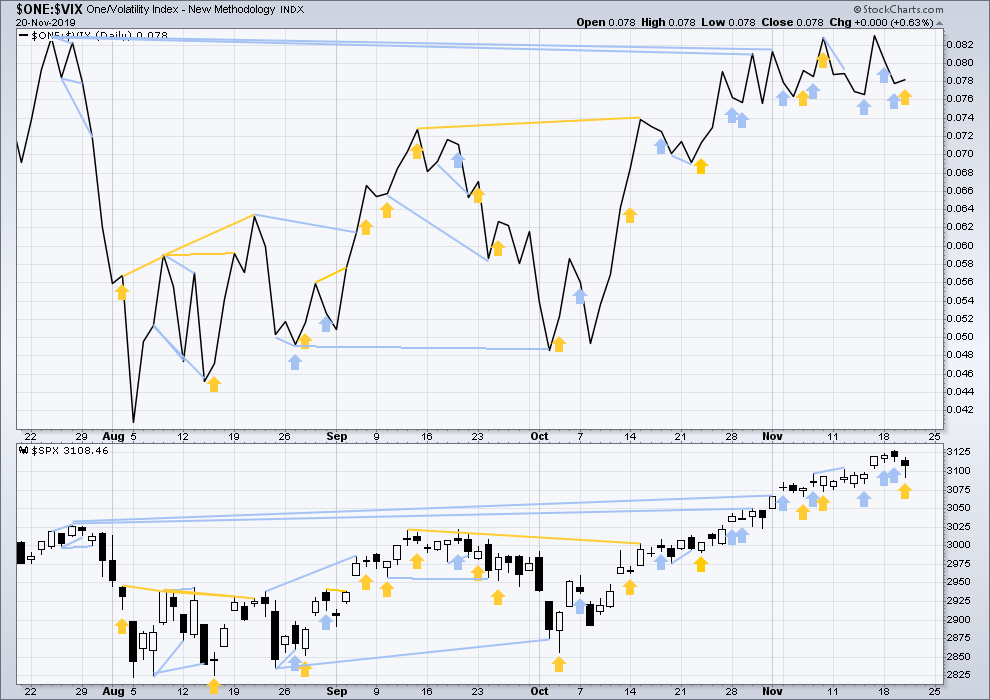
Click chart to enlarge. Chart courtesy of StockCharts.com. So that colour blind members are included, bearish signals
will be noted with blue and bullish signals with yellow.
Today price has moved lower, but inverted VIX has moved higher. This divergence is bullish for the short term but should not be given weight in this analysis.
DOW THEORY
Dow Theory confirmed a bear market in December 2018. This does not necessarily mean a bear market at Grand Super Cycle degree though; Dow Theory makes no comment on Elliott wave counts. On the 25th of August 2015 Dow Theory also confirmed a bear market. The Elliott wave count sees that as part of cycle wave II. After Dow Theory confirmation of a bear market in August 2015, price went on to make new all time highs and the bull market continued.
DJIA: 23,344.52 – a close on the 19th of December at 23,284.97 confirms a bear market.
DJT: 9,806.79 – price has closed below this point on the 13th of December.
S&P500: 2,532.69 – a close on the 19th of December at 2,506.96 provides support to a bear market conclusion.
Nasdaq: 6,630.67 – a close on the 19th of December at 6,618.86 provides support to a bear market conclusion.
With all the indices having moved higher following a Dow Theory bear market confirmation, Dow Theory would confirm a bull market if the following highs are made:
DJIA: 26,951.81 – a close above this point has been made on the 3rd of July 2019.
DJT: 11,623.58 – to date DJT has failed to confirm an ongoing bull market.
S&P500: 2,940.91 – a close above this point was made on the 29th of April 2019.
Nasdaq: 8,133.30 – a close above this point was made on the 26th of April 2019.
Published @ 07:50 p.m. EST.
—
Careful risk management protects your trading account(s).
Follow my two Golden Rules:
1. Always trade with stops.
2. Risk only 1-5% of equity on any one trade.
—
New updates to this analysis are in bold.


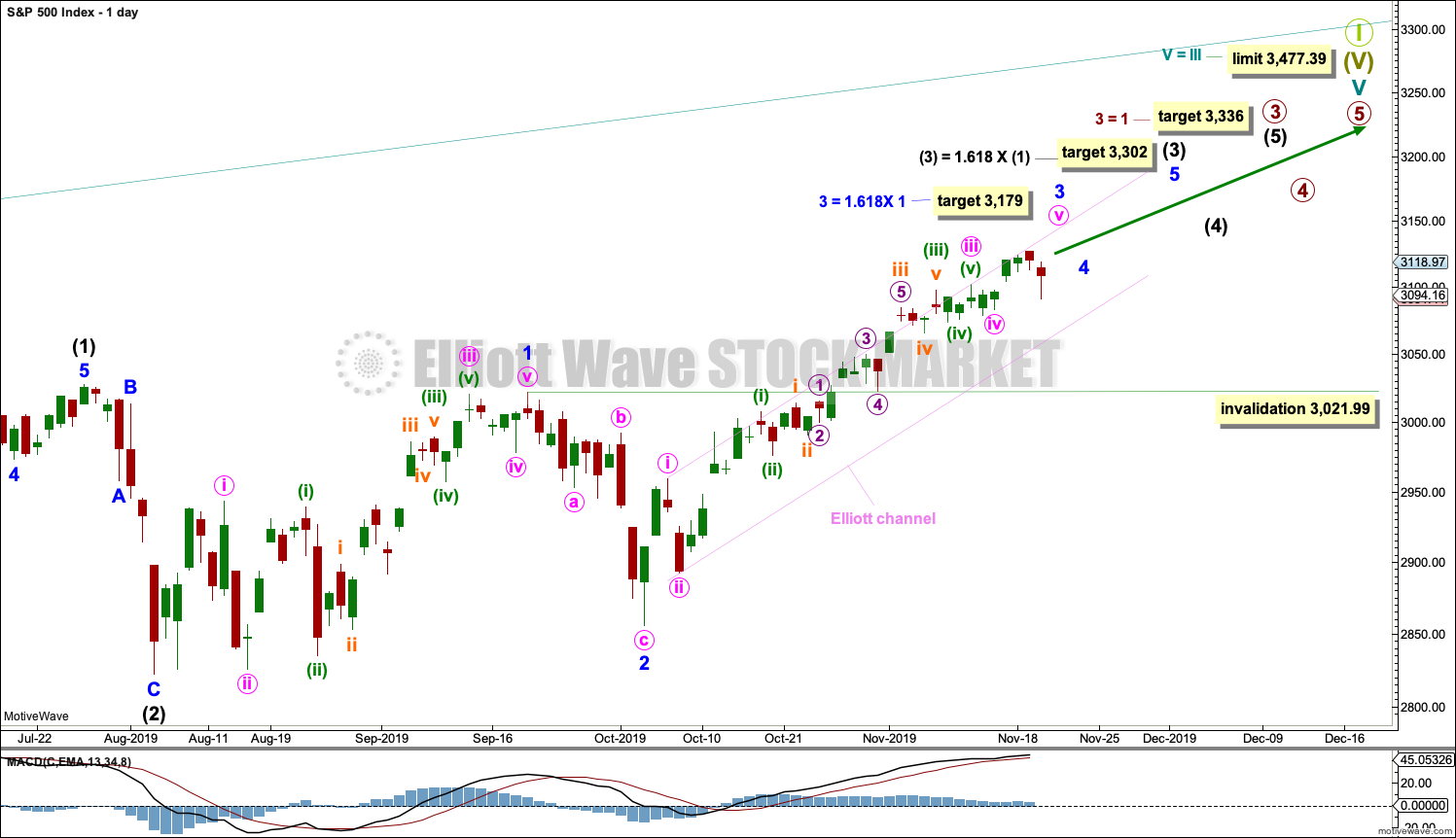
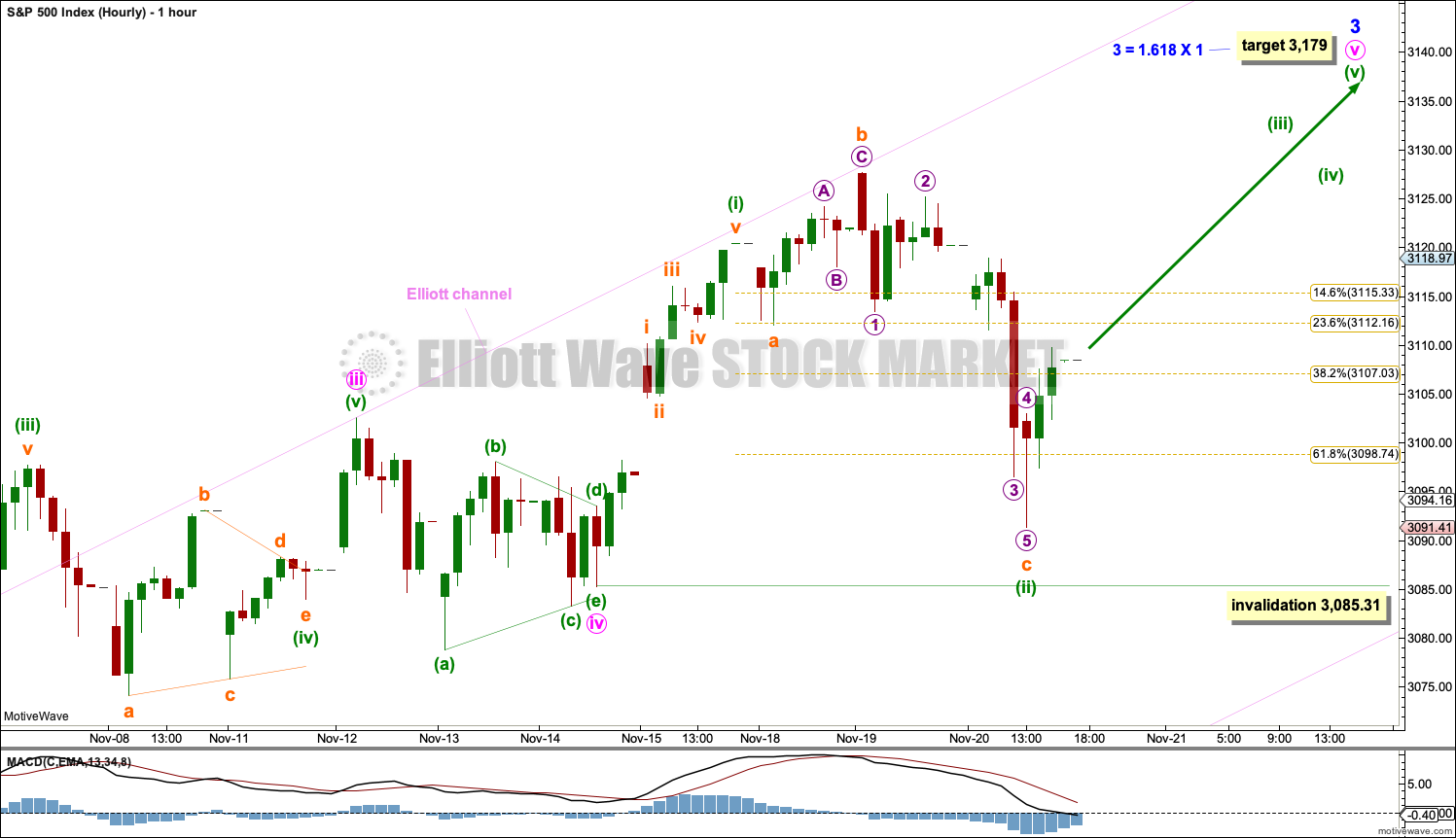
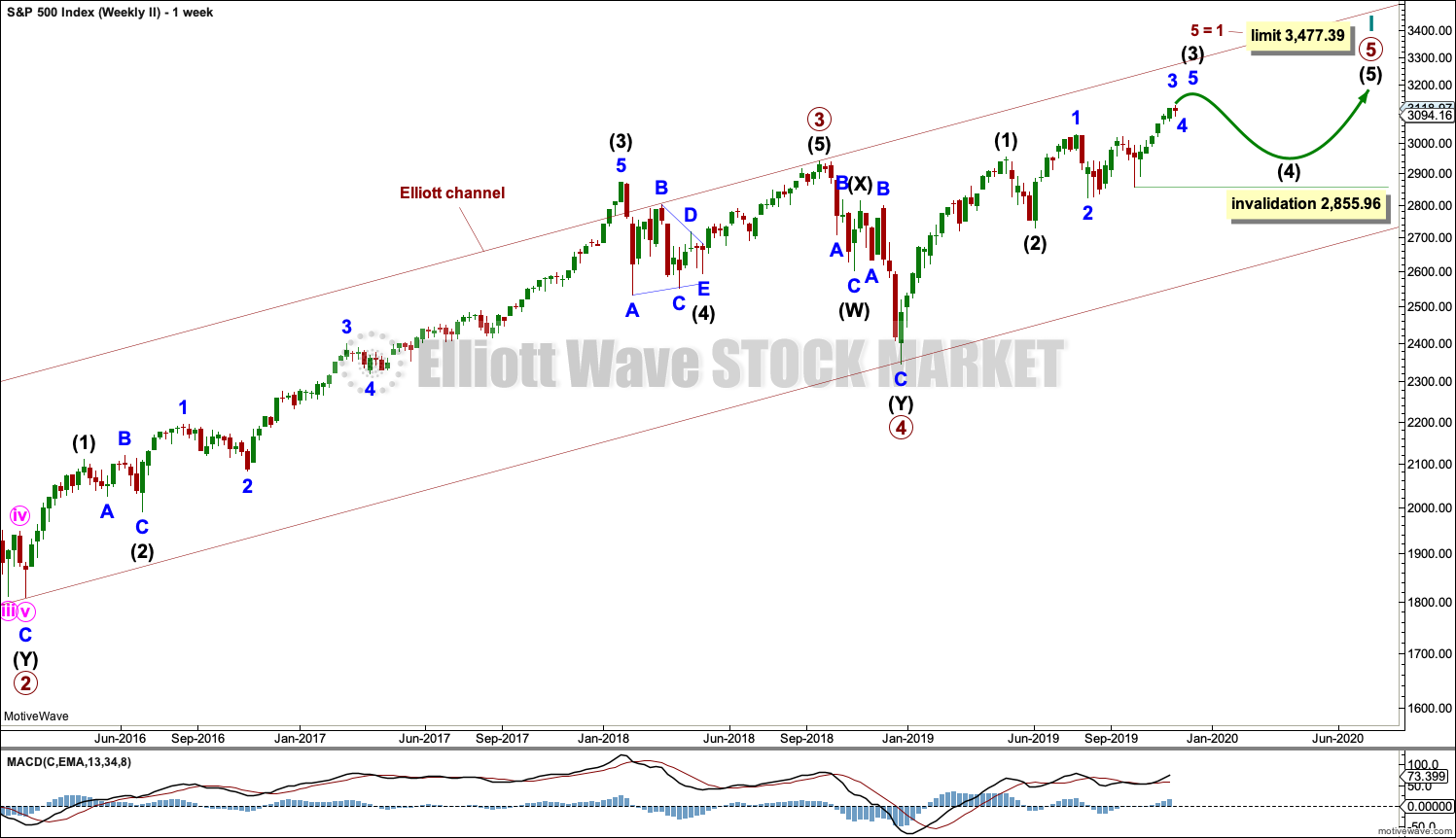
Hourly chart updated
I feel this may be a triangle developing on the SPX:
Nov 19: A (down), then B, and 1 of C
Nov 20: 2 and 3 of C and the beginning of 4
Today: 4 continues so far, maybe a triangle?, I’m expecting new low below 3091 later today to finish C… Or will this be a 3 down, not a C?
So short, stop 3111 (wave 1)
Hello Lara, Mind updating your Bitcoin charts? Or do you think this is just a deeper wave 2 than you originally expected? Thanks
and if the invalidation point is breached what does that mean for the medium term/corrective wave count? TY
With you on that Belmont, i hold/trade btc.
I have it as an wxy ending at approx 7870 y = w, so hoping this is the bottom, if we move below the 7700, then a much deeper correction unfolding.
Wave 2 can go as low as the beginning of wave 1, or 7296. It’s a large correction so far (80% of wave 1), so it obviously opens the idea that this is not a wave 2.
If 7296 is broken, then what was called 1 up will probably be an X, and you will need a correction pattern to the downside (what is currently labeled 2 would be an A, and you would need B-C or any other corrective action).
If you like BTC, you should love XRP, which has more potential upside in my view.
I may be able to post a chart later today, if I do so it will be here in comments (or the next published analysis)
I expect its just a deeper second wave correction.
Only if it makes a new low below 7,446.99 would that view change, then I’d expect it’s a continuation of primary 2 as a double zigzag, and the target would then be 7,365
Lara,
I do not see the same numbers as you do. I get my data in TradingView, BTC/USD from Coinbase.
I see the low on October 23 at 7296.44 and today’s low (this morning) at 7374.50
Still looking good, price poked above the 3111, if we get the same at the the 3118.5 then Lara’s hourly chart is unfolding to the upside.
Some relatively high volatility overnight action in /ES. Bullish so far: two retests of today’s (yesterday’s) lows and both strongly rejected. But the drama is ongoing.
Thinking about what it means if the invalidation level at 3085 gets broken to the downside, I came up with this alternative count, which I think would become the main if that invalidation happens. “Shorty” minute v and the minor 3 is already complete. And now an A or W down, and a B/X in progress. (Why? Because the minor 4 has to be longer in time to be reasonably proportional to minor 2, and probably deeper in price too).
thanks Kevin! it’s the planning around the ‘what if’ scenarios that help me sleep at night!
…also, just had your pragmatic trading book printed out and will be digging in over the next few weeks. just piercing the first few chapters but so far it’s information dense and detailed but very well articulated!
Thank you Hokipa. Yes, I’m sure for many it’s “TLDR”!!! Lol!!! If you get value from it and would like to offer a recommending comment I can put on my web site, I’d be most grateful.
If anyone else here would like a copy, send me email at zinc1024 at the gmail place.
I’ll be writing an addendum on how to deploy options spreads using the analysis and setup types covered in book, maybe over the holidays.
I’ve sold one copy. I’m rich!!!! Lol!!! Well, you obviously don’t do these crazy things for the money.
I just noticed you said “printed it out”. Whoa! In color??? Because color is important for most of my charts. If you did black and white, the charts lose significant information encoded in the colors (particularly the bar coloring to show trend state). Just so you are aware. A section in the book thoroughly covers the use of coloring for trend state, and after that, all the charts us my MVTI trending state coloring indicator (just as the charts I post here usually do).
print color? oh lord no! I’ll use pens during my reading to fill in and make it an ‘interactive’ learning experience. things are always a compromise in Indonesia so its one sided printing, 181 pages, but it was bound into a book for less than a dollar lol. I considered your point but was excited to use the pen as it will force me to really examine and know the examples. hands on, book learning so to speak.
Flag down.